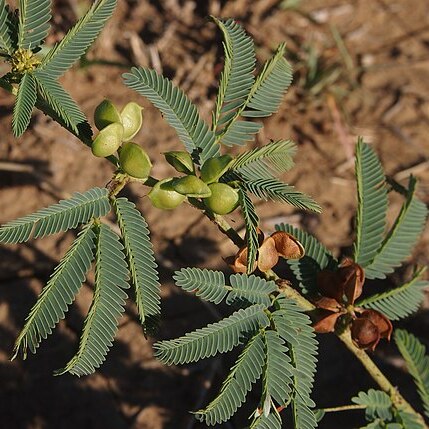Perennial, erect to ascending herb to 0.9 m tall, with glabrous or puberulous branches. Leaves glabrous or rarely ±pilose; stipules caducous to deciduous, ovate, 2-8 mm long, 2-4 mm wide, acuminate; petiole with 1-3 large glands (typically elongate-elliptic and often wider than petiole), also often between upper pinnae-jugae; pinnae narrowly lanceolate, 1-3 (-4)-jugate, the longest (25-) 40-80 mm long, with processes on main axis minute or absent; leaflets 10-40-jugate, narrowly oblong, obtuse and apiculate, 4-12.5 mm long, 1-3 mm wide, glabrous or ciliolate, rarely puberulous beneath. Inflorescence an axillary head; peduncle 5-22 mm long, glabrous or occasionally puberulous, with 2 bracts 1.5-4.5 (-8) mm long. Flowers yellowish green; lower ones with calyx c. 1.3 mm long and petals c. 2 mm long; upper ones with calyx 1-1.4 mm long and petals 2-2.5 mm long. Pod subcircular to asymmetrically oblate, 7-9.5 mm long, 6.5-8 mm wide, glabrous or puberulous. Seeds 1 (-2), oval to broadly obovate, 4-5 mm long, 3-4 mm wide.
More
A herb which keeps growing from year to year. It grows 0.5-1 m high and spreads 0.4-1.5 m wide. The stems are erect or curve upwards. They are slender. The leaves are twice divided. They are on stalks 1.5 cm long. There are 1-3 pairs of stalks with leaflets The leaflets are 0.3-1.3 cm long by 0.25 cm wide. There are 20-39 opposite pairs of leaflets. They are grey-green. The upper flower heads are 0.8 cm across. They are yellow with green petals. They are on 2 cm long stalks in the axils of leaves. The lower flower heads are 1.4 cm across with yellow petals and modified stamens which are like petals. The pods are 0.7-1 cm long and 0.8 cm wide. They are flat and dark brown. They have some hairs.

